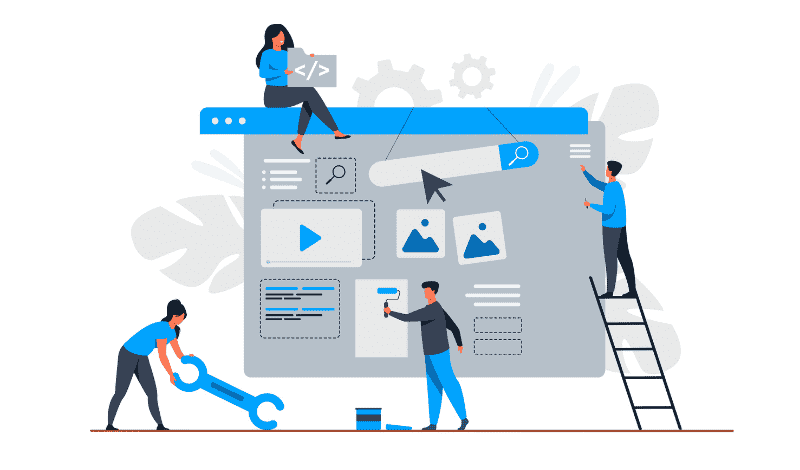Nowadays, If you’d like your business to grow and succeed, you must have an online presence. It promotes the brand, advertises your products/services, creates a connection with your customers, and more importantly, provides a solid platform to execute different marketing strategies. To build your web presence, you need to hire a right web design agency to create your website. You’ll need to send your request to web design agencies in a standardized form, commonly called an RFP for web design.
What is Website Design RFP?
A website design RFP contains detailed information regarding the project. It defines the work outlines, tasks, clarifies the goal of the project, explains the criteria of vendor selection, and has details like functionality, deadlines, and contact information. Vendors utilize RFP to evaluate the scope of work, the timeline, and the budget to offer the best solution to the job.
Benefits of Web Design RFP
- It provides an overall view of what is required to bring your concept to reality.
- It is a way to optimize and break down a complex project.
- It allows you to find new vendors that might aid any future endeavors.
- It makes sure that the web design company can meet deadlines and requirements for projects.
- It can help you get the most economical solution.
Web Design RFP Template
If you would like to download the word format of the Web Design RFP, you can download it from here.
Strategy
Design
Development
Support
How to Structure a Great Website Design RFP
A Web Design RFP should have these sections:
1. About the Organization
- Here you can describe your organization, mission and goals.
- You can also mention challenges and problems faced by organization to serve your audience digitally.
- Purpose of Website Design and how it would change the value of an organization.
- Also, describe where would you launch this website and what regions/states would it serve if in case of it is product-based.
2. About the Project
- Here you can provide high level overview of the project including objectives, scope and how website redesign will improve your marketing and operations,
- Describe if you have existing infrastructure and you want to enhance and make necessary modifications.
3. Audience of the Website
Describe the type of visitors to your site and the monthly volume of the visitors.
4. Scope of the Project
- Discovery and Design: Describe if the client will provide the written requirements or requirements will be written by the vendor. Describe if the vendor is supposed to create content, information architecture, detailed wireframes and visual designs or if you would provide the content.
- Website Development: Describe features, pages, sections of the site, user capabilities and future scalability. Also, mention if it is a single-page website or multi-page website?
- Post Production Support: Describe if you require a vendor to provide Post Production Support.
5. Technical Requirements
Mention expected page templates will be on the website.
A. CMS Requirements
- This is the most important section and you may want to cover all aspects of your website requirements.
- You can write a list of required features and functions, technology consideration, and methods for building a website.
- Mention how many types of browser it supports?
- Describe if you want to view analytics and website usage (user activity, sessions, userbase).
- Here you can also describe if a website has to be developed in a number of phases and breakdown features and functions to be implemented in each phase. This is necessary to prepare a structured business plan and monitor website development progress along with customer feedback.
B. Third-Party Integration Requirements
- Mention the third party integration you need in the website(connecting website with SMS gateway, payment gateway, APIs for data pulling)?
C. Analytics Requirements
6. Support and Maintenance Requirements
- Each and every project needs support from the technical team, you need to describe how long support and maintenance you need initially.
- Do you want continuous development and upgrade?
- Also, mention support would be needed to maintain the website performance.
7. Project Timeline
- Project timeline is important to decide the website launch date and till then encourage the audience with your upcoming solution.
- You need to describe how soon you want to complete the design and discovery phase, development phase, testing and deployment.
- This will give us an idea to website development companies to prepare execution plans.
Read More: How Long Does It Take To Build a Website?
8. Budget
- Budget is required to be evaluated initially.
- Describe your budget range for website design, development and deployment.
- Any further explanations for support and maintenance required for a particular duration.
9. Proposal Requirements
Describe criteria for developers to provide a detailed estimate in a structured manner.
Proposal Timeline
- Describe how quickly you want to complete Project discovery and requirement gathering sessions. Once you send requirements to web development vendors, mention how soon you want them to provide feedback with a set of questions and suggestions.
- Then a pre-planned timeline to receive quotations from web development teams.
- Describe the timeline for the design phase, development phase and launching date.
10. Proposal Format
- Company Overview
- Past Performance
- Proposed solution and team
- Proposed methodology
- Cost Estimation and Timeline to complete the project
- Demonstration of Design and Development Process
- Client Reference
11. Evaluation Criteria
We have prepared an evaluation criterion for vendors to fulfill our requirements. See the table below to complete and respond at the best level.
| Tasks | Selection Percentage |
| Proposal Submission | 10% |
| Work Experience | 20% |
| Cost & Timeline to complete the project | 30% |
| Presentation | 20% |
| Project Staff & Client Reference | 10% |
| Proposed Solution & Support | 10% |
Read More: How to Write a Web App RFP

 App Development
App Development Web Engineering
Web Engineering AI Services
AI Services Startups
Startups Health / Fitness
Health / Fitness Education
Education Social
Social Nonprofit
Nonprofit Fintech
Fintech Logistics
Logistics Government
Government HR Software
HR Software About Simpalm
About Simpalm Our News
Our News Client Testimonials
Client Testimonials Careers
Careers Awards
Awards Resources
Resources Information
Information


